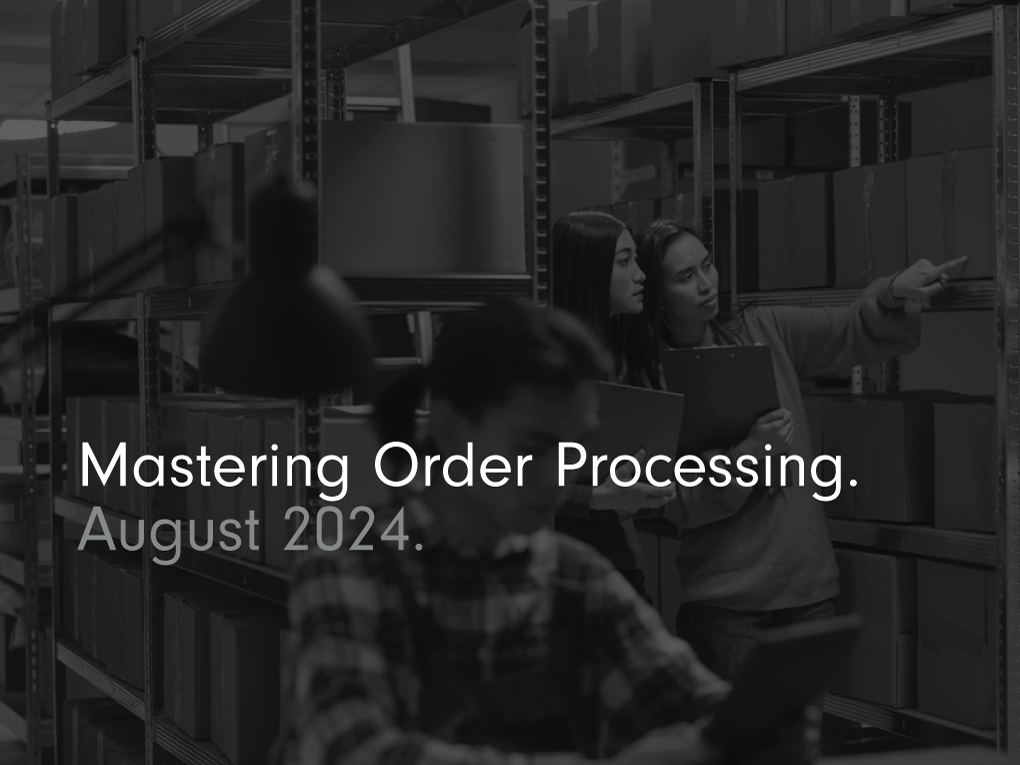Mastering Order Processing for Logistics Success.

Efficient order processing is key to business success. It doesn’t matter if you’re running an e-commerce platform, managing a supply chain, or owning a small business – getting your order processing right can make a big difference to your profits.
This guide will dive into the details of order processing in logistics. You’ll find useful insights, practical advice, and examples from the real world to help you smooth out your operations and make your customers happier.
Table of Contents
Introduction.

Order processing is crucial for any logistics operation. It’s about taking customer orders, handling them correctly, and making sure they’re delivered when they should be. For e-commerce and supply chain businesses, being good at this is key to keeping customers happy and staying ahead of competitors. In this blog post, we’ll guide you through the whole process, from when an order is placed to when it’s delivered, and we’ll cover the tech, best practices, and challenges that come with it.
The Order Processing Cycle.

To fully grasp the importance of order processing, it’s vital to understand the cycle involved. Let’s break it down step by step:
1. Order Placement
This is the first stage where customers place their orders through various channels, such as websites, mobile apps, or in-store kiosks. The order details, including the products, quantities, and delivery preferences, are captured at this stage.
2. Order Entry
Once the order is placed, it enters the system for processing. Order entry involves verifying the order details, checking product availability, and confirming payment terms. Accurate order entry is critical to prevent errors and delays.
3. Order Picking
In this stage, warehouse staff locate and pick the items listed in the order. Efficient order-picking methods, such as batch picking and zone picking, can significantly speed up this process.
4. Order Packing
After picking, the items are packed securely for shipment. Proper packaging ensures that the products arrive in good condition and minimizes the risk of damage during transit.
5. Order Shipping
The final step involves shipping the order to the customer’s address. Customers receive shipping information like tracking numbers and delivery dates for live updates on their orders.
Sales and Purchase Order Processing.

To better understand order processing, let’s differentiate between sales and purchase order processing.
Sales Order Processing
Sales order (SO) processing involves handling customer orders for products or services. It starts with order placement and includes order entry, picking, packing, and shipping. Efficient sales order processing ensures timely delivery and enhances customer satisfaction.
Purchase Order Processing
Purchase order (PO) processing, on the other hand, deals with orders placed by a company to its suppliers. It includes requisition creation, supplier selection, order placement, and receiving goods. Proper processing helps maintain optimal inventory levels and supports demand forecasting.
Technologies and Tools.

In the digital age, technology plays a pivotal role in optimisation. Here are some essential tools and software to consider:
Enterprise Resource Planning (ERP) Systems
ERP systems like SAP Business One provide a comprehensive solution for managing financials, sales, inventory, and production. They offer real-time insights into your business operations, enabling you to make informed decisions. This is important for processing orders because it makes workflows more efficient, reduces mistakes, and improves communication between departments. This helps ensure that customer orders are filled accurately and on time.
Warehouse Management Systems (WMS)
WMS solutions, such as Korber WMS, are designed to streamline warehouse operations. They offer features like barcode scanning, automated picking, and inventory tracking, enhancing overall efficiency. These systems are crucial for order processing as they ensure accuracy, speed, and real-time visibility, leading to quicker fulfilment and improved customer satisfaction.
E-commerce Platforms
Online stores can easily manage orders with platforms like Shopify and WooCommerce, which integrate smoothly with order processing systems. This integration is essential for efficient order processing, as it reduces errors, speeds up fulfilment, and enhances customer satisfaction by ensuring timely delivery.
Best Practices for Efficient Order Processing.

Implementing best practices can significantly improve the speed and accuracy of your processing. Here are some tips to consider:
Batch Picking
Batch picking involves grouping multiple orders with similar items, allowing pickers to collect items for several orders simultaneously. This method reduces travel time and increases efficiency.
Barcode Scanning
Barcode scanning technology improves item identification accuracy and reduces human errors in the picking and packing process.
Real-Time Inventory Tracking
Real-time inventory tracking helps maintain optimal stock levels and prevents stockouts. It also provides visibility into inventory movements and aids in demand forecasting.
The Effect of Order Processing on Customer Experience and Growth.

Efficient processing directly influences customer satisfaction and business profitability. Here’s how:
Enhanced Customer Satisfaction
Quick and precise order processing means faster deliveries and fewer mistakes, making customers happier. This increases the chances they’ll come back and recommend your business.
Improved Customer Retention
Customers who enjoy a smooth order process tend to stick with your brand, boosting customer loyalty and retention.
Increased Business Profitability
Streamlined order processing reduces operational costs, minimizes errors and improves overall efficiency, ultimately boosting your bottom line.
Challenges and How to Overcome Them.

Order processing is not without its challenges. Here are some common issues and strategies to overcome them:
Errors in Order Entry
Manual data entry can lead to errors in order details. Implementing automated order entry systems and using order management software can help eliminate these errors.
Delays in Order Fulfillment
Shipping delays can frustrate customers and harm your reputation. Ensure you have efficient logistics partners and consider using advanced shipping solutions for timely deliveries.
Inventory Management Issues
Maintaining optimal inventory levels can be challenging. Utilize inventory management software to track stock levels, set reorder points, and conduct regular audits.
Conclusion
Mastering order processing is key for e-commerce entrepreneurs, supply chain managers, and small business owners to succeed. By getting a handle on the order processing cycle, using technology smartly, following best practices, and tackling challenges head-on, you can greatly improve how you handle orders.
Remember, being efficient doesn’t just make customers happier; it also boosts your business’s growth and profits. We urge you to try out the tips from this blog post and share your experiences and questions in the comments. If you’re looking for more info, check out our related content and resources.
Frequently Asked Questions.
Order processing is the workflow of managing customer orders for goods or services from the initial order placement through to final delivery.
Streamline your order processing by adopting ERP and WMS systems, using batch picking and barcode scanning, and keeping track of inventory in real-time.
Efficient order processing enhances customer satisfaction, improves customer retention, and reduces operational costs, ultimately boosting business profitability.